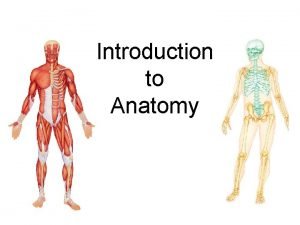Introduction to Anatomy a The Greek philosopher Aristotle





























- Slides: 29

Introduction to Anatomy (a)

The Greek philosopher, Aristotle, thought the heart, not the brain, was the location of intelligence and thought. The word "brain" appears on an ancient paper-like document (a "papyrus") called the Edwin Smith Surgical Papyrus. 1700 BC


Overview of Anatomy n n Anatomical terminology from ancient Greek and Latin Branches of anatomy ¨ Gross anatomy ¨ Microscopic anatomy n Cytology n Histology ¨ Developmental anatomy n Embryology ¨ Comparative anatomy n Scale uses metric system

Structural organization from simplest to most complex n n n Chemical Cellular Tissue – group of cells similar in structure and function Organ – 2 or more tissue types performing specific function Organ system – group of organs acting together to perform specific function Human organism

Levels of Organization:

Anatomy at Different Scales (Metric Scale)

Organ systems n n n Integumentary Skeletal Muscular Nervous Endocrine Cardiovascular Lymphatic/immune Respiratory Digestive Urinary Reproductive

n Branches of anatomy ¨Gross anatomy ¨Microscopic anatomy n Cytology n Histology ¨Developmental anatomy n Embryology ¨Comparative anatomy

n Gross Anatomy The anatomical position (see right) ¨ Directional and regional terms ¨ n n n n Medial v. lateral Proximal v. distal Cephalad v. caudad Interior v. superior Superficial v. deep Ipsilateral v. contralateral Flexion v. extension Ulnar deviation v. radial deviation Dorsiflexion v. plantar flexion Eversion v. inversion Medial rotation v. lateral rotation Abduction v. adduction Supination v. pronation Protraction v. retraction Elevation v. depression Rotation










Body planes and sections - cut into sections along a flat surface called a plane (also called coronal) (also called XS – cross section)

Body Planes, Sections and Lines Sagittal- any longitudinal plane dividing the body into right and left parts n Mid-sagittal or median plane- divides the body into equal right and left halves n Coronal- longitudinal plane dividing the body into anterior and posterior parts n Mid-coronal- divides the body into equal anterior and posterior parts n

n Horizontal or axial plane- transverse plane passing through the body at right angles to the longitudinal plane; divides into superior and inferior portions

Sectional Anatomy 3 sectional planes: n transverse ( or cross) section n frontal (or coronal) section n sagittal section (mid- and para-)

n Body cavities and membranes ¨ Dorsal cavity divided into cranial ¨ Ventral cavity containing viscera divided into two main cavities n Thoracic cavity ¨ ¨ n and vertebral (visceral organs) 2 lateral pleural cavities Central mediastinum containing pericardial cavity Abdominopelvic cavity ¨ ¨ Abdominal cavity Pelvic cavity ¨ Serous cavities are slit-like spaces lined by serous membranes (serosa): n n Parietal serosa forms the outer wall of the cavity Visceral serosa covers the visceral organ ¨ Other smaller cavities: in head, between joints


Body Cavities

Serosa

Naming of serous membranes (serosa) : 1. ) parietal or visceral Parietal serosa forms the outer wall of the cavity Visceral serosa covers the visceral organ 2. ) pericardial, pleural, or peritoneal* Pericardial: heart Pleural: lungs Peritoneal: abdominal *The 2 nd adjective can become a noun: pericardium, pleura, peritoneum

In the clinic: Abdomino-pelvic Regions
 Aristotle was student of
Aristotle was student of Plato teacher of
Plato teacher of Which greek philosopher defined the art of persuasion
Which greek philosopher defined the art of persuasion Plato persuasive appeal
Plato persuasive appeal Where does tragedy come from
Where does tragedy come from Greek philosopher democritus
Greek philosopher democritus Body planes and sections
Body planes and sections Aristotle greek theater
Aristotle greek theater School of modern greek language thessaloniki
School of modern greek language thessaloniki Protagoras
Protagoras American philosopher
American philosopher Harry potter spisateljica
Harry potter spisateljica Plato’s classical philosophy is “the power to rule”.
Plato’s classical philosophy is “the power to rule”. Social contract philosopher
Social contract philosopher French philosopher mathematician
French philosopher mathematician Italian physicist mathematician astronomer and philosopher
Italian physicist mathematician astronomer and philosopher Philosopher translator secretary architecture
Philosopher translator secretary architecture The philosopher's way 5th edition
The philosopher's way 5th edition Philosopher of cordoba
Philosopher of cordoba Origin of number system
Origin of number system David armstrong philosopher
David armstrong philosopher Weeping philosopher
Weeping philosopher Philosopher giving a lecture on the orrery
Philosopher giving a lecture on the orrery Alison jaggar
Alison jaggar Philosopher puns
Philosopher puns Simile in harry potter
Simile in harry potter Philosopher painting
Philosopher painting Enlightened philosopher pathfinder
Enlightened philosopher pathfinder Aristotle pupil
Aristotle pupil Biodata aristotle
Biodata aristotle



















































